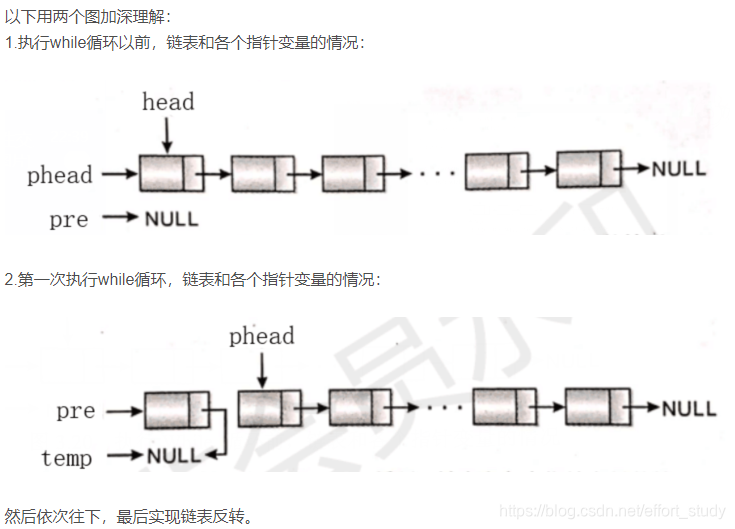题目
分别实现反转单向链表和反转双向链表的函数。要求:如果链表长度为N,时间复杂度要求为O(N),额外空间复杂度为O(1)
反转单链表分析
用三个指针分别记录前一个节点temp,当前节点pre和后一个节点phead。循环中,将temp后移到pre的位置,pre后移到phead的位置,phead移动到下一个节点,并将当前节点pre的指针域指向前一个节点temp。当phead到达链表末尾时,即phead-next=null的时候,当前的末节点是pre,将其指针域指向temp。恰好完成整个链表的反转,循环结束,返回反转后链表的头结点pre
link InvertList(link head){
link pre,phead,temp;
phead = head; //将phead指向链表头,做游标使用
pre = NULL; //pre为头指针之前的节点
while(phead != NULL){
temp = pre;
pre = phead;
phead = phead->next;
pre->next = temp; //pre接到之前的节点
}
return pre;
}

完整代码
#include<iostream>
#include<cstdlib>
using namespace std;
class list {
public:
int data;
class list* next;
};
typedef class list node;
typedef node* link;
link FindNode(link head, int position_data) {
link phead;
phead = head;
while (phead != NULL) {
if (phead->data == position_data)return phead;
phead = phead->next;
}
return phead;
}
link InsertNode(link head, int position_data, int data) {
link phead = new node;
phead = FindNode(head, position_data);
link insertnode = new node;
if (!insertnode) return NULL;
insertnode->data = data;
insertnode->next = NULL;
if (phead == NULL) { //插入第一个节点
insertnode->next = head;
return insertnode;
}
else if (phead->next == NULL) phead->next = insertnode; //插入最后一个节点
else { //插入中间节点
insertnode->next = phead->next;
phead->next = insertnode;
}
return head;
}
link DeleteNode(link head, int position_data) {
link top = head; //保留头指针
link phead = FindNode(head, position_data);
if (head == phead) { //删除头结点
head = head->next;
delete phead;
}
else {
while (top->next != phead) top = top->next;
if (phead->next == NULL) { //删除尾结点
top->next = NULL;
delete phead;
}
else {
top->next = phead->next;
delete phead;
}
}
return head;
}
link InvertList(link head) {
link pre, phead, temp;
phead = head; //将phead指向链表头,做游标使用
pre = NULL; //pre为头指针之前的节点
while (phead != NULL) {
temp = pre;
pre = phead;
phead = phead->next;
pre->next = temp; //pre接到之前的节点
}
return pre;
}
link CreateList(int a[], int n) {
link head, phead, newnode;
phead = new node;
if (!phead) return NULL;
phead->data = a[0];
head = phead;
for (int i = 1; i < n; i++) {
newnode = new node;
newnode->data = a[i];
newnode->next = NULL;
phead->next = newnode;
phead = phead->next;
}
return head;
}
void PrintList(link head) {
link phead = new node;
phead = head;
cout << "链表元素如下: " << endl;
while (phead != NULL) {
cout << phead->data << "->";
head = phead;
phead = phead->next; //phead按序往后遍历整个链表
if (!phead) cout << "NULL" << endl;
}
}
int main() {
int position_data, data;
link head, phead;
int n=5;
cout << "请输入初始链表元素个数: " << endl;
//cin >> n;
int a[5];
cout << "请依次输入链表元素: ";
for (int i = 0; i < n; i++) cin >> a[i];
head = CreateList(a, n);
PrintList(head);
cout << "请输入预插入位置之前的元素和要插入的元素(例:5 8): ";
cin >> position_data >> data;
head = InsertNode(head, position_data, data);
cout << "插入之后的";
PrintList(head);
cout << "请输入想删除的链表元素: ";
cin >> position_data;
head = DeleteNode(head, position_data);
cout << "删除之后的";
PrintList(head);
cout << "反转之后的";
head = InvertList(head);
PrintList(head);
return 0;
}
反转双链表
双向链表的反转,就是交换每个节点的前向指针和后向指针,然后调整链表的头指针和尾指针。
构建双向链表节点,与单链表节点相比,多了一个指向前一个元素的指针域。
struct Node{
int data;
Node* next;
Node* prev;
};
完整代码
#include <iostream>
struct Node
{
int data;
Node *next; // 指向下一个节点
Node *prev; // 指向前一个节点
};
//对链表进行反转
void reverse(Node **head)
{
Node *temp = NULL;
Node *current = *head;
//交换每个节点的后向指针和前向指针
// 1-->2-->3, 假设2为current.
while (current != NULL)
{
temp = current->prev; //temp=1
current->prev = current->next; //3-->2
current->next = temp; //2-->1
current = current->prev; //3-->2-->1, current变为3,继续往后循环。
}
//总结:先处理前向指针,然后处理后向指针。这些操作都只对当前节点(current),不涉及其它节点。
//1.缓存前向指针
//2.将后向指针赋值给前向指针
//3.将缓存的前者指针,赋值给后向指针
//4.当前节点指针移动到下一个待处理节点
//修改头指针之前,先检测链表是否为空链表,或者只有一个节点的情况
if (temp != NULL)
*head = temp->prev;
}
// 给定链表的头指针(head)以及一个整数,插入一个新的节点至链表的头部
// 之所以传入双指针,因为函数中需要修改链表
void push(Node** head, int newData)
{
//1. 分配新节点内存
Node* newNode = new Node;
//2. 赋值
newNode->data = newData;
//3. 将原始头节点做为新节点的后向指针,而前向指针置为NULL
newNode->next = (*head);
newNode->prev = NULL;
//4. 将原始头节点的前向指针置为新的节点
if ((*head) != NULL)
(*head)->prev = newNode;
//5. 将头指针置为新的节点
(*head) = newNode;
}
void printList(Node *head)
{
while (head != NULL)
{
std::cout<<" "<<head->data<<" ";
head = head->next;
}
std::cout << std::endl;
}
int main()
{
//初始化链表为:10<->8<->6<->4<->2<->0
Node* head = NULL;
push(&head, 0);
push(&head, 2);
push(&head, 4);
push(&head, 6);
push(&head, 8);
push(&head, 10);
std::cout << "Original DLL is: ";
printList(head);
reverse(&head);
std::cout << "Reversed DLL is: ";
printList(head);
return 0;
}





 这篇博客介绍了如何在O(N)时间和O(1)空间复杂度内反转单向和双向链表。提供了详细的代码实现,包括反转单链表、双向链表的插入、删除和打印链表的操作。通过交换节点的前后指针完成双向链表的反转,对于单链表则是通过迭代方式更新节点指针来实现反转。
这篇博客介绍了如何在O(N)时间和O(1)空间复杂度内反转单向和双向链表。提供了详细的代码实现,包括反转单链表、双向链表的插入、删除和打印链表的操作。通过交换节点的前后指针完成双向链表的反转,对于单链表则是通过迭代方式更新节点指针来实现反转。
















 3007
3007

 被折叠的 条评论
为什么被折叠?
被折叠的 条评论
为什么被折叠?








